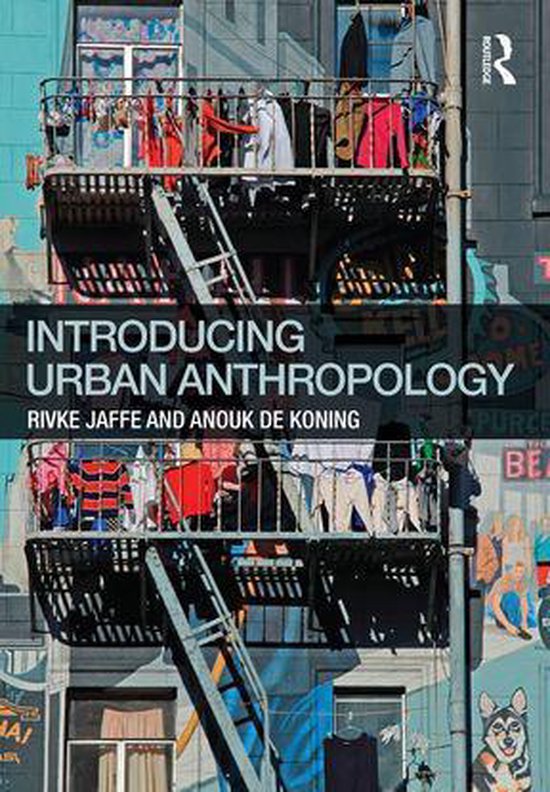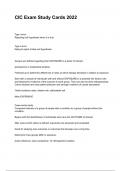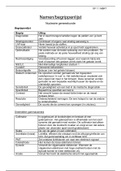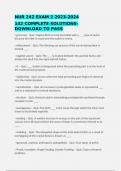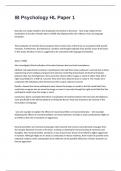Lecture 1 (18 nov): introduction
Jaffe & De Koning, ch 1
How to define a city
- Economic function
- Physical form
- Demographic characteristic: absolute size of population, high population density, relative high
diversity
- Urbanism as a way of life and blasé attitude
- Constructivist def: the city as a social construct: if perceived as a city, a city is a city if people
believe that it is one —> who has the power to define a city as such
- Cities as assemblage; the intersection of multiple dynamic and unstable networks and flows of
people, animals, money, things and technology
—> Louis Wirth: a city may be defined as a relatively large, dense, and permanent settlement of
social heterogenous individuals
—> the city has been a melting-pot of races, people and cultures. It has brought people together
from the ends of the earth because they are different and thus useful to one another
Anthropology in and of the city
- the fact that many anthropological studies are conducted in cities —> does not make them urban
anthropology
- What makes urban anthropology is their explicit reflection on the implications of the urban
context in which these phenomena occur
- urban anthropology: anthropology that engages explicitly with the question of how social life is
constructed by and experienced within urban context
- Such contexts are characterized by specific features: size, density, heterogeneity, anonymity and
inequality
Of the city:
- urbanism as a way of life
- The way in which we interact with others (anonymity, importance of how you look)
- Derivative of urbanism as a way of life: cities as centers of consumption, social movement
- Spatial turn: focus on urban spaces
- Derivative of spatial turn: new mobility paradigm, representation and inter-city rivalry
!1
, - Anything that takes place in these spaces or is about these places
Traditional and urban anthropology
Historical overview of urban studies
- Predecessors
- 19th century novelists: dickens, Zola
- Sought to research the lives of the urban poor in the context of industrial urbanism
- Highlight exploitation of the urban poor, used their research to make a case for
governmental interventions
- Reformers: academically oriented authors: Engels, Tillema
- Early Chicago school: Park, Burgess, Anderson
- This model understood human behavior in cities to be shaped by the urban environment and
its competitive character.
- ‘if men define situations as real, they are real in their consequences’
- early urban anthropologists
Against the background of massive rural-to-urban migration in the global South, anthropologists
began to follow their ‘peasant’ interlocutors as they moved to the cities, studying how these
migrants coped in new urban environments.
- William Foote Whyte
- St clan drake & Horace Clayton
- Robert Redfield & oscar lewis
- Oscar Lewis: culture of poverty: held that a culture developed in response to conditions of
urban poverty helped reproduce the marginalization of people in poor neighborhoods
!2
,- Copperbelt studies
- conducted from a ‘colonial liberal’ perspective, traced the social transformations associated
with rural-to-urban migration and industrialization
- these studies argued for analyses that focused on particular cases or situations to capture the
dynamic nature and complexity of urban social life.
- Max Gluckman
- The classic ideas about ethnicity were developed within the Copperbelt studies
- Ethnicity is a social construct
- Not about ethnic core: core culture
- About the boundaries between different tribal groups
- Cities and development
- The spatial turn
- People began to focus on the power inherent in configurations of space
- The relation between urban space and social and cultural life in cities
Cities in the global south
- mega urbanisation
- Slums and housing
- Informal sector
Lecture 3; the production of urban space
Jaffe & De Koning, Ch 1 & 2, Lefebre
- ‘the fact that many anthropological studies are conducted in cities does not necessarily make
them urban anthropology in our view. What makes their work urban anthropology is their explicit
reflection on the implications of the urban context in which these phenomena occur’
- ‘we define “urban anthropology” as anthropology that engages explicitly with the question of
how social life is structured by and experienced within urban contexts’
Anthropology in and of the city
- ‘we must distinguish between phenomena that occur in cities but are not generated by
urbanisation processes as such, and phenomena that are legitimately elements of cities in the
sense that they play an active role in defining the shape and logic of urban outcomes’
!3
, What counts as anthropology of the city
1. urbanism as a way of life
2. the spatial turn; the social production of urban spaces
3. offshoot of urbanism as a way of life: cities as centres of consumption, social movements
4. offshoot of spatial turn: new mobility paradigm
5. inter-city competition and cooperation, representation of cities
Close relationship between urbanism and social diversity
- ‘A city is composed of different kinds of men: similar people cannot bring a city into existence’
- ‘The city has been the melting-pot of races, people, and cultures. It has brought together people
from the ends of the earth because they are different and thus useful to one another’
All human activity requires space: even thinking
Best way to study urban societies
- To focus on space as a social product that is contested by different actors
- space is created by human action
Kinds of space, with different degrees of solidity
- built-up environment (fixed use of space)
- Temporary use of public space
- Symbolic use of space
- Statue, street names
—> Urban spaces have an impact on how we behave
Richard Sennett on the social diversity of cities
- cities are meant to be places which concentrates different races, social classes, ethnicities, life-
styles: the mixtures of difference has seemed to writers on cities from Aristotles to Arendt to
stimulate people in crowds’
- Th public realm can simply defined as a place where strangers meet
- The difference between public and private lies in the amount of knowledge one person or group
has about others; in the private realm, as in a family, one knows others well and close up,
whereas in a public realm one does not; incomplete knowledge joins to anonymity in the public
realm
!4


